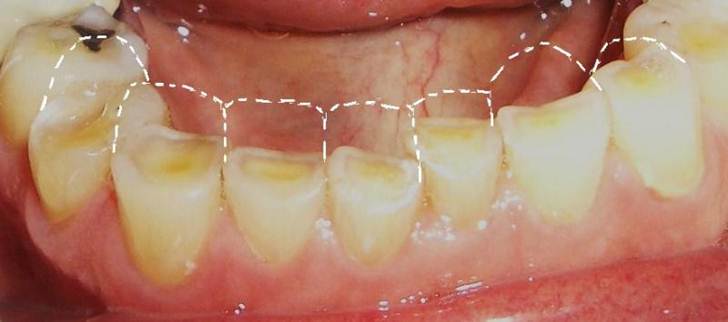What is Dental Erosion?

Dental erosion is a very common condition that results in tooth wear and loss of tooth’s hard substances. Besides caries, there are several conditions that cause this loss and are not generated by bacteria. The process of erosion is very similar to the one that happens during caries, but the causes are completely different and should be distinguished. This condition is a chemical process that is caused different types of acids that teeth get in touch with.
How Does Erosion Happen?
When the acid comes in touch with the hard tissues of a tooth they start a process of dissolution. The enamel is the first substance that they attack, and affect the hydroxyapatite, which is the main component. That way it weakens the structure of the tooth and it makes it much more susceptible to other damaging factors. The acids cause the pH levels in the mouth to drop and leads to loss of enamel and in a lot of cases dentin.
What are the Causes of Dental Erosion?
Intrinsic and extrinsic acids are the reasons why a lot of people experience erosion. The extrinsic acids come from food and drinks that people consume often, while the intrinsic is a result of a gastric reflux.
A lot of different conditions and diseases that affect the gastrointestinal system can cause a backflow of the gastric contents. It those acids comes in touch with teeth on a regular basis that will definitely cause erosion. Such conditions include Gastro-esophageal reflux disease, chronic drinking, bulimia, anorexia and much more. Pregnancy and morning sickness can be very damaging to the teeth, that is why every pregnant woman should consult her dentist and have regular checkups. Dry mouth or xerostomia is a condition that might accelerate the level of erosion of teeth.
There is a large number of drinks and foods that we eat every day but we are not aware that they cause erosion. Each one of these factors can be damaging to tooth’s hard tissues mostly if they are consumed excessively. The first ones ranked on this list are the carbonated drinks, that can be especially harmful to children. These drinks contain high levels of phosphoric and citric acids and if they get in touch with the surfaces of teeth, that can lead to many problems. Another thing that people do is keeping these drinks for a longer time in their mouth or even gargle. The longer the contact is, the stronger the effects will be. A number of fruit drinks are extremely harmful due to the citric acids. If you think that juices are very healthy, you should think twice. They not only contain acids but also added sugar. If your favorite drink is wine, here’s some bad news for you. The pH levels of wine are around 3.5 which causes an acidic environment in the mouth. Unfortunately, sports and energy drinks, vitamin waters and vitamin C tablets are the drinks you should also avoid.
When it comes to food, all of the citric fruits such as oranges, lemons, limes can be damaging if they are consumed too often. Apples are another fruit that might lead to erosion. If a person’s diet is rich in sugars and starch the chances are there will be some type of dental erosion.
Certain types of medicine, such as aspirin, antihistamines, vitamin C and iron products are correlated with this condition. Workers in some industries that are constantly exposed to acids or their fumes, might notice changes in their teeth.
What are the Symptoms of Dental Erosion?
The signs vary depending on the stage of the condition. When the erosion is still in the incipient stages the patient will only experience sensitivity due to the loss of enamel. This feeling will be much stronger if there is a significant enamel loss and the dentin is exposed. Patients will experience sharp pain when they eat/drink hot, cold or sweet drinks or food.
The most obvious symptom of erosion is a loss of dental tissues. Once patients notice that their teeth don’t look like they used to before, that is the moment when they visit a dentist. In the first stages there is only a slight loss of enamel, and if the condition is not treated it will progress. The most commonly affected surfaces are the palatial ones of the upper frontal teeth and the occlusal surfaces of the lower molars. In the beginning, there will be flat and shiny facets that are shallow. Once the condition progresses, these lesions become deeper and the dentin is exposed. The occlusal surfaces might even lose their normal morphology and become flat surfaces.
Another thing that changes is the appearance of the teeth. They will become more yellow, mostly because of the exposed dentin. In some cases, the fillings will remain the same as before and will be prominent and very visible. Since the teeth structure is damaged, some of the teeth might break, crack or chip.
How to Manage Dental Erosion?
The treatment depends on the severity of the case. If the condition is in an early stage, then it can be treated with changes in the lifestyle. Dentists tend to find the real cause and eliminate it. It can be drinking a lot of carbonated drinks, fruit juices or a digestive disorder. These factors should be taken care of, otherwise, the erosion will only progress.

If there’s already a more severe substance loss, then that requires a more extensive treatment. In these cases, the dentists also start with discovering the reason and working on eliminating it. The loss of the dental tissues might really change a person’s lifestyle and make it much harder. That is why the teeth have to be protected with restorations. In most cases, the erosion can be treated with fillings. But for the more severe ones, dental crowns might be necessary. That is why you should always schedule regular checkups with your dentist.